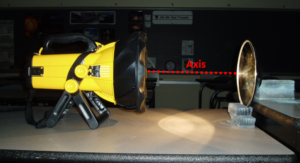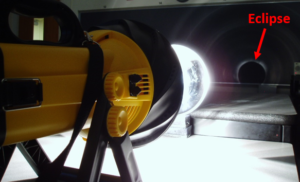Model Description
This demonstration illustrates how to concentrate radiant energy, solar or other, using a parabolic reflecting dish to produce high enough heat fluxes to burn paper. This demonstration should take 10 minutes.
Engineering Principle
The sun is located far enough from the earth that radiation arrives here in nearly parallel beams. A parabolic dish will spectrally reflect the parallel beams towards the focus of the dish, greatly amplifying the radiation intensity of the original beam. In doing so, anything placed into the focus of the dish will incur much more power per unit area than the original beam, such that an object at the focus may reach very high temperatures.
For indoor convenience, a spotlight can be used with a high candlepower rating. The candlepower rating is usually based on the brightest spot in the non-uniform beam of the spotlight. Although it is known that the sun can provide roughly 1000 [W/m2] on a sunny summer day, conversion of the spotlight candlepower rating to actual radiant power flux [W/m2] is not accurate without either measurement or the manufacturer’s data. A 15,000,000 candlepower spotlight is used as it is the largest battery powered spotlight currently on the market, available from various manufacturers.
The concentration of light depends on the precise geometry and surface properties of the mirror. The more parabolic and reflective the surface, the sharper the focus will be. More light will be focused for a larger beam diameter, and mirror aperture to match.
What You Need
| Item | Quantity | Description/Clarification |
|---|---|---|
|
15,000,000 candlepower spotlight |
1 |
Available from various manufacturers. The one shown has an aperture diameter of 8 ¾ ”. $60-100 |
|
Parabolic Mirror |
1 |
Highly reflecting parabolic surface, with aperture diameter approximately that of the spotlight. This mirror has an aperture diameter of 8 ¾ ”. Approximately $45 |
|
Mirror Stand |
1 |
Improvised materials. Goal is to align mirror axis with spotlight axis. |
|
Paper / Match/ Tissue |
1 |
Thin strip of any readily combustible material. |
|
Thermometer / Thermocouple |
1 |
Measures temperature at mirror focus. |
How It’s Done
In Class: (a) The mirror and spotlight can be easily aligned either before or during class.

Figure 1
If the stand for the mirror is ready to go at a known height, the alignment will take half a minute. Above is an improvised mirror stand using chalk erasers. The spotlight comes with an adjustable stand (see Figure 1). The axis of the mirror should be the same as the axis of the spotlight for optimal concentration. The axial distance between the mirror and spotlight is arbitrary, but should not be too large. The alignment is fine tuned by observing the shadow of the mirror on the wall behind the mirror. In the image below, the spotlight beam diameter is slightly larger than the mirror diameter, showing a symmetrical eclipse image (mirror blocking light) on the wall (see Figure 2).

Figure 2
(b) Ask for a volunteer to locate the hot spot of the mirror. This is done by moving a finger along the central axis towards the mirror. At the focus, the finger will rapidly get very hot on the side facing the mirror. Instinct will cause the student to remove the finger very quickly. CAUTION: There is a risk of a being burned if the finger is kept in the focus too long, if a higher power spotlight is used, or if a better quality mirror is used. Try it first before the class does, and give fair warning to your volunteer!
(c) Once it has been proven that the focus is a hot spot, try burning a piece of tissue paper, match, or plain paper. At the focus, the paper will quickly smoke and even ignite! However, if the paper is even a little bit off the focus, it may not even smoke. The key is to zero in on the focus, which for this mirror is about 2-3 inches from the surface along the primary axis. This is best done by knowing where to look ahead of time, and by fine tuning the location by increasing the brightness of the spot on the paper as it is moved. This all assumes that the mirror axis is aligned well with the spotlight axis.
(d) Knowing that paper was burned, have students guess the temperature at the focus and then measure it with a thermometer or thermocouple.
Additional Application:
(a) After building up the hopes of the class that they will witness the incredible power of the sun, first take out a puny little 1,000,000 [cp] light. This will hopefully draw some “booing” from the class. Then get rid of the 1,000,000 [cp] light, and impress them by hauling out the markedly larger 15,000,000 [cp] light.
(b) Show images of solar concentrators being used in research and the power industry, either before or after the demonstration.
(c) If the concentrator is designed to collect heat, the useful heat delivery can be expressed as the radiant power reflected to the receiver which is positioned at the focus, less the thermal losses from the receiver to the ambient.
where:
= useful heat delivered by the collector
= optical efficiency of the mirror, depending on surface properties
= irradiation on the mirror surface
= aperture area
= receiver area
= overall heat transfer coefficient of the collector / receiver
= collector temperature
= ambient temperature
The maximum temperature of the receiver (collector) can be estimated by setting the useful heat delivery to zero in the above expression. Concentrating solar power towers, like the one at Sandia National Labs, can achieve up to 5000 [K].
(d) The concentration ratio is defined as the area of the mirror aperture to the area of the receiver (collector) placed at the focus of the mirror.
For a two-dimensional mirror (parabolic trough), the theoretical limit of concentration is 216 in air and 324 in glass. For a three-dimensional mirror (parabolic dish), the theoretical limit of concentration is 46,000 in air and 103,500 in glass. The highest solar concentration that has been achieved in the lab is 56,000!
